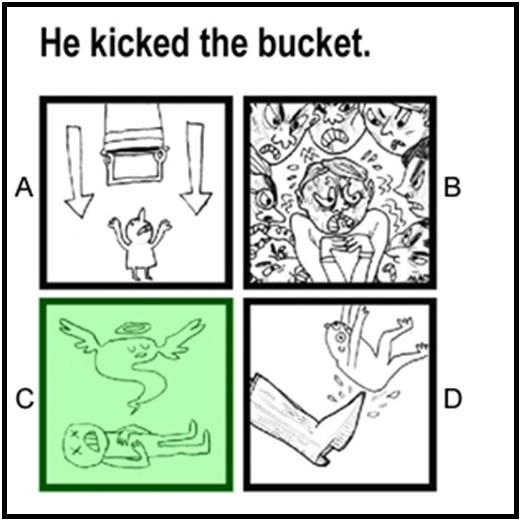New study first to show figurative language comprehension relies upon brain’s motor regions
January 18, 2022
USC neuroscientists demonstrate that, like literal language, abstract metaphors are embodied in the brain.
By Mike McNulty
“Bend your ear.” “Grasping at straws.” “Kick the bucket.” English is filled with figurative language that makes meaning by evoking physical actions of the human body.
During the past decade, a number of scientific studies have shown that brain regions thought to only be responsible for physical movements are also involved in our linguistic abilities. For example, injuries to the sensorimotor cortex will also impact comprehension of action verbs related to that same area. Thus, a stroke survivor who has limited hand movement is also less likely able to identify or name hand-related verbs, such as “handle” or “grasp.”
Now, a team of USC neuroscientists have gone a step further by demonstrating that the brain regions responsible for physical movements are also involved in the ability to comprehend non-literal, metaphorical language.
“It’s a fascinating finding because an abstract figure of speech like ‘handle the situation’ doesn’t have anything to do with literal hand movements,” said USC Chan Associate Professor Lisa Aziz-Zadeh. “Nevertheless, we now have strong evidence that conceptual language is also embodied within the brain’s sensorimotor regions.”
Results of the study led by Aziz-Zadeh, the publication’s senior author who is also affiliated with the USC Brain and Creativity Institute at the USC Dornsife College of Letters, Arts and Sciences, were published this week in Brain & Language.
Aziz-Zadeh’s research projects explore the idea that rudimentary sensorimotor brain regions — which perhaps were originally designed for processing our own body states — may be intrinsically involved in processing aspects of higher cognition, such as language, thought, emotions, empathy and social understanding.
The publication’s first author is Eleonora Borelli, a visiting PhD student from the University of Modena and Reggio Emilia (Modena, Italy), who worked with Aziz-Zadeh for six months.
Lower action metaphor comprehension in motor stroke survivors supports embodied language theory
In order to test the hypothesis that, like literal language, metaphors are grounded in sensorimotor representations, the researchers examined participants’ abilities to comprehend four categories of metaphors: common action-related metaphors (e.g., “knock on wood”); novel action metaphors (e.g., “they sprinkled him with cheer”); common non-action metaphors (e.g., “she was a cold fish”); and novel non-action metaphors (e.g., “she weighed less than her own shadow”).
Their prediction was that action metaphors would be less accurate in individuals with stroke compared to a healthy control group, and that novel action metaphors would be less accurate than over-learned metaphors.
A study group of 14 right-handed adult stroke survivors with mild-to-moderate weakness in the right sides of their bodies were compared to a control group of 23 participants without neuromotor impairments. The researchers predicted that action metaphors would be less accurate in the stroke group, as compared to the healthy group, and that novel action metaphors would be less accurate than over-learned metaphors.
On a screen, participants were shown a written metaphorical sentence, and then asked to select which of four hand-drawn pictures correctly depicted the sentence’s metaphorical meaning. To avoid using the hand or upper extremity, all participants were asked to say their answer choice aloud, with the experimenter then selecting the corresponding answer. The stimulus set consisted of 55 total metaphors, and all participants completed the task within 15 minutes.
Results showed that the stroke group had significantly lower accuracy for action metaphors than for non-action metaphors. The stroke group also showed significantly decreased accuracy for understanding the less-familiar novel metaphors. These findings strongly support the theory that motor-related brain regions are important not only for literal action-related language comprehension, but also for action-related metaphor comprehension.
“These results reveal how concepts are represented in the brain,” Aziz-Zadeh said. “They support the notion that even abstract concepts may be grounded in sensorimotor representations.”
⋯
Next by tag Research ⟩







